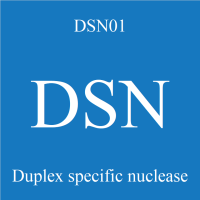
2x TaqMan Probe qPCR Mix HotStar Taq bulk pack
2021-12-20
2x SYBR qPCR Master Mix separate rox
2021-12-20Product Number
- LG01 T4 DNA Ligase
- LG02 Fast T4 DNA Ligase
Storage conditions
Store at -20°C
Description
FAST T4 DNA Ligase is designed for the efficient ligation of cohesive-ended DNA inserts into plasmid vectors in just 5-10 minutes (blunt-ended inserts in as little as 15-30 minutes). FAST T4 DNA Ligase catalyzes the joining of two strands of DNA between the 5'-phosphate and the 3'-hydroxyl groups of adjacent nucleotides in either a cohesive-ended or blunt-ended configuration. The enzyme has also been shown to catalyze the joining of RNA to either a DNA or RNA strand in a duplex molecule but will not join single-stranded nucleic acids.
Biological Source
E. coli strain expressing a recombinant clone.
Molecular Weight
68kDa.
Requirements
Mg2+, ATP and DTT. The optimum concentration of Mg2+ is 10mM. Mn2+ may be substituted for Mg2+ but is only 25% as effective as Mg2+.
Inhibition
50% inhibition by greater than 150mM NaCl (activity measured at nicks. Other inhibitors include 0.2M K+, Cs+, Li+, NH4+ and 1mM spermine.
Inactivation
Heat to 70°C for 10 minutes.
Components
FAST T4 DNA Ligase (200 U/μl)
2 X Ligation Buffer
Applications
Cloning of restriction fragments.
Joining linkers and adapters to blunt-ended DNA
Unit Definition
One unit of FAST T4 DNA Ligase is defined as the amount of enzyme required to give 50% ligation of Hind III fragments of λ DNA (5' DNA termini concentration of 0.12 µM, 300- µg/ml) in a total reaction volume of 20 μl in 30 minutes at 16°C in 1x T4 DNA Ligase Reaction Buffer.
Physical Purity
The purity is ≥90% as judged by SDS-polyacrylamide gel electrophoresis with Coomassie® blue staining.
Standard Applications
We recommend using a 1:1, 1:3 or 3:1 molar ratio of vector: insert DNA when cloning a fragment into a plasmid vector. These ratios will vary with other types of vectors, for example, cDNA and genomic cloning vectors. The following example illustrates the conversion of molar ratios to mass ratios for a 3.0kb plasmid and a 0.5kb insert DNA fragment.
Protocol
The following ligation reaction of a 3kb vector and a 0.5kb insert DNA uses a 1:1 vector: insert ratio. Typical ligation reactions use 100-200ng of vector DNA.
- Assemble the following reaction in a sterile microcentrifuge tube:
| vector DNA | 100ng |
| insert DNA | 17ng |
| 2 X Ligation Buffer | 5μl |
| T4 DNA Ligase | 0.5–1μl |
Nuclease-Free Water to final volume of 10μl
- Incubate the reaction at room temperature for 5-10 minutes for cohesive-ended ligations, or 15-30 minutes for blunt-ended ligations.
Notes
- Ligation reactions performed using the 2 X Ligation Buffer do not need to be cleaned up before transformation.
- Concatamers may form as ligation products. The extent of concatamer formation depends on the vector:insert ratio, incubation temperature and incubation time. This should be taken into account when screening transformants.
Order
| LG01 | T4 DNA Ligase | 200U/μl, with ligase buffer |
| LG02 | Fast T4 DNA Ligase | 200U/μl, with Fast ligase buffer, only 5 minute ligation |


